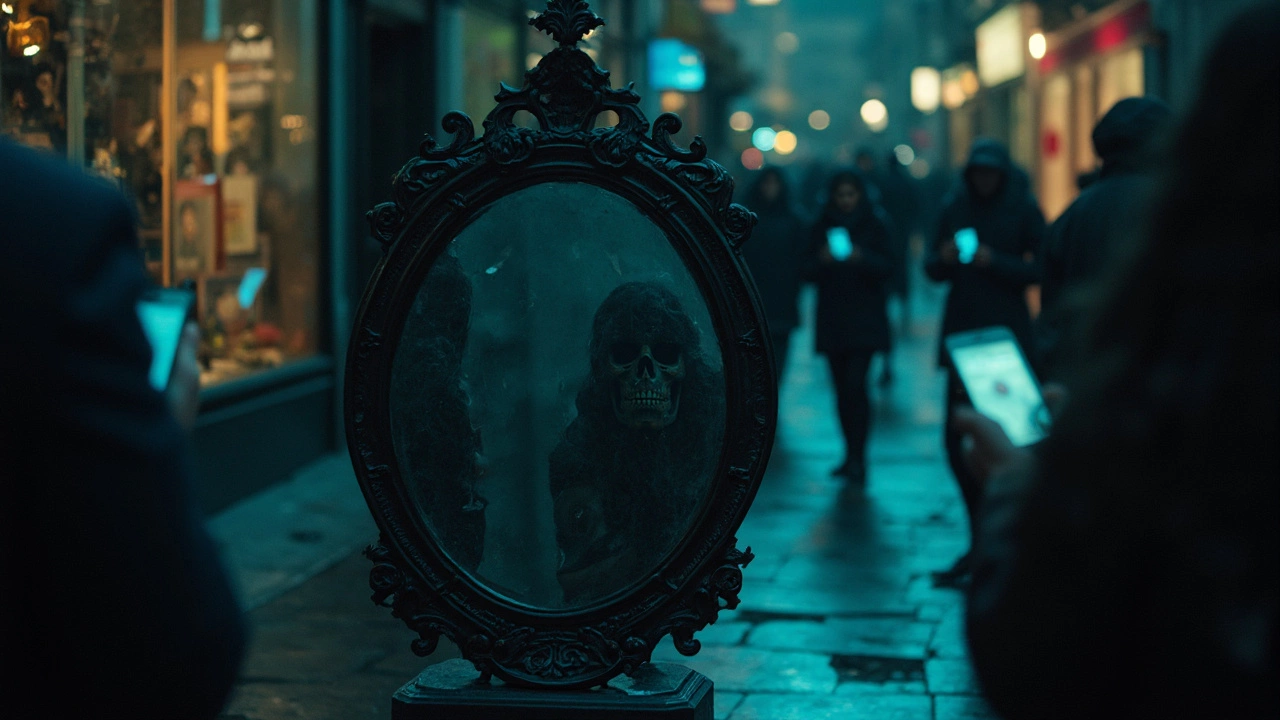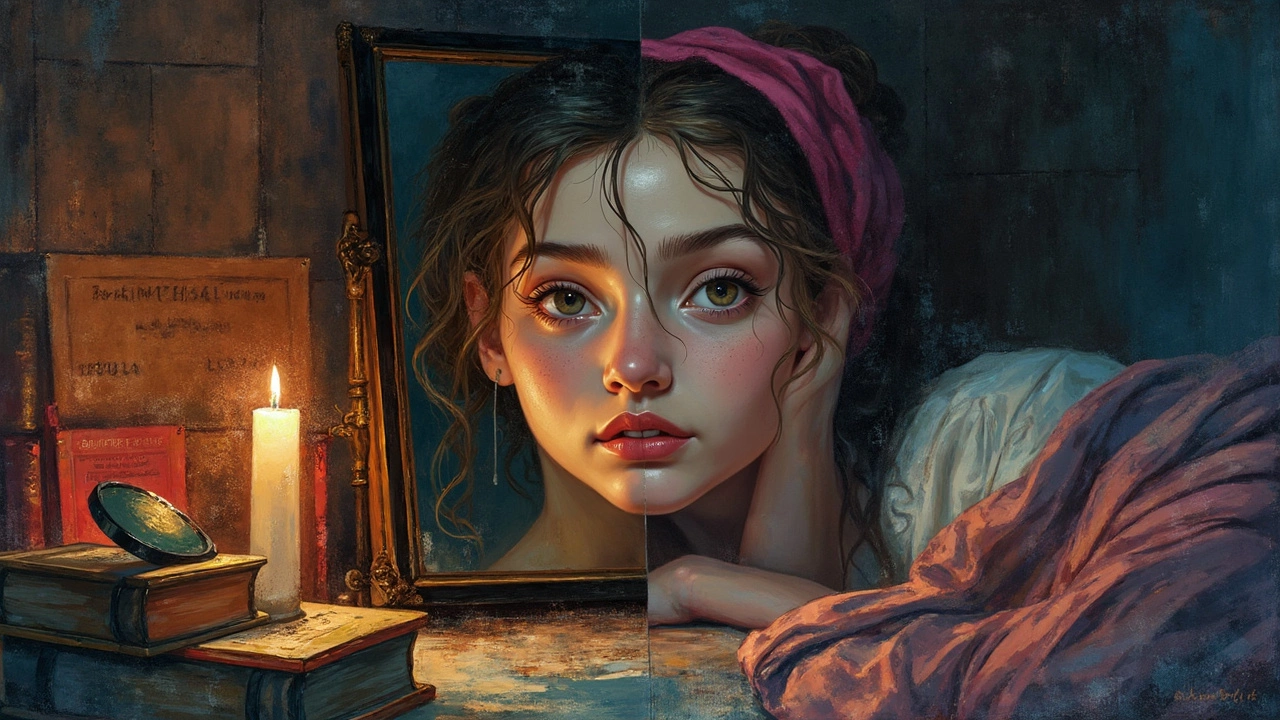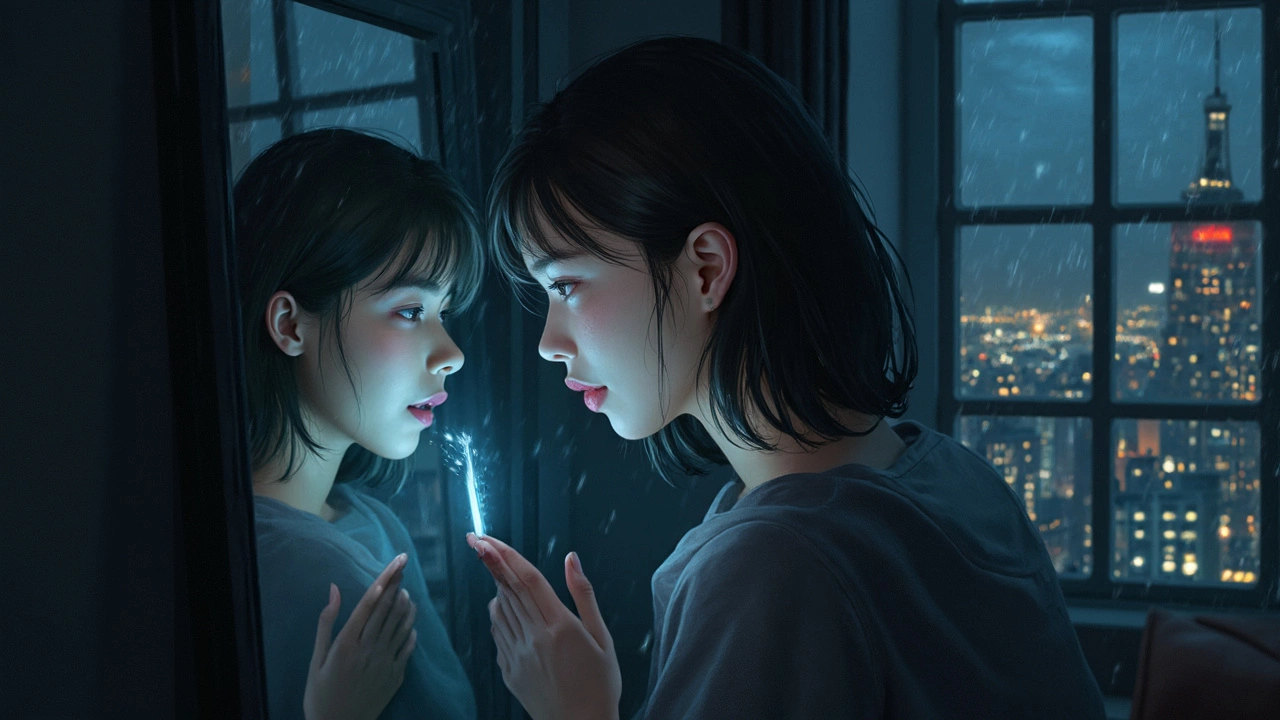Chances are, you’ve stared right into a black mirror today—maybe for hours. Not the antique on the wall, but the glassy, blank glow of your phone, tablet, or TV before it lights up. We talk about black mirrors like they’re just spooky objects from ghost stories or old-timey magic, but they’re everywhere right now, as real as the device in your hand.
The reason “black mirror” grabs so much attention? Whenever your screen is off, you get this smooth, dark reflection staring right back at you. It’s both literally a mirror and a symbol for how we see ourselves in tech. And here’s the kicker: mirrors have always had this job—not just showing your face, but making you think about what’s behind the surface. There’s some handy stuff to know about using mirrors in everyday life, whether it’s getting a sharper look at your outfit or thinking through a problem by staring into your own eyes for a minute.
This isn’t just about spooky superstitions or sci-fi references. We’re talking about the real way mirrors (especially black ones) play into how we live, work, and see ourselves. So, how did we get from ancient bronze reflectors to swiping on glass all day? Stick around, because it’s way more than just a history lesson.
- The Origins of the Black Mirror
- How Black Mirrors Reflect Our Digital Lives
- Hidden History: Black Mirrors Through The Ages
- Practical Mirror Tips for Everyday Use
- What Your Reflection Can Teach You
The Origins of the Black Mirror
Before your phone screen went dark and turned into a black mirror, people were already using these mysterious objects way back in history. The most basic black mirrors weren’t high-tech at all—they were actually made from shiny, dark stones like obsidian. Ancient folks in places like Mexico or Greece would polish these stones until they reflected just enough to catch your face, but they always kept things a little shadowy and mysterious.
It wasn’t just for checking out your hairstyle, either. Black mirrors were tied to fortune-telling, spiritual rituals, and even some wild early science experiments. For example, in 16th-century Europe, some thinkers and magicians swore by these mirrors for scrying. That just means staring into one until you see images, trying to uncover secrets or answers. And this isn’t just some old legend—a famous English philosopher and mathematician named John Dee used a black obsidian mirror to try to talk to angels and predict the future. His mirror is still in the British Museum, by the way, if you ever want to see it for yourself.
If you’re wondering when black mirrors started looking more like the glass you see on electronics, that took a while. Regular glass mirrors with a dark background didn’t really spread until the 19th century, mostly in fancy parlors and artist studios. That’s because painters used "Claude glasses"—small, portable black mirrors—to help frame their landscapes and see shapes and shadows better. Here’s a fun list of who used black mirrors, and why:
- Ancient Mesoamericans: Obsidian stone for both practical uses and religious rituals.
- 16th-century Europe: Mystics like John Dee for scrying and "divining" information.
- 19th-century artists: Claude glasses for sketching and composing paintings.
So when you hear about a black mirror today, it’s not just a tech thing. It goes way back, touching on magic, art, and the very basic human itch to understand who we are—and maybe peek a little further into the unknown.
How Black Mirrors Reflect Our Digital Lives
Here’s a weird fact—almost every piece of technology you use with a screen acts like a black mirror. Before you tap your phone or flick on your computer, you see your own face staring back. It’s not just about checking your hair or seeing if you have something in your teeth. That black screen is both a literal and a symbolic mirror of our modern society and habits.
Think about how often you check your phone every day. In 2023, most people touched their smartphones over 2,000 times daily. That’s a lot of one-on-one face time with a digital mirror. But it’s more than just looking; it’s about constant connection, reaction, and self-feedback. Apps and social media keep us hooked, shaping how we see ourselves and each other, turning the black mirror into a feedback loop for our digital selves.
Even the creator of the TV series “Black Mirror” said the name was picked because when you look at any turned-off screen, it’s literally a black mirror—a haunting reflection of our attachment to technology. That’s where the deeper meaning kicks in. These devices show us not just who we are, but who we pretend to be or want to be, thanks to selfies, filters, and curated feeds. Our reflection isn’t just physical, but digital too—constantly updated, constantly judged (sometimes harshest by ourselves).
- Phones and tablets: The dark glass before it powers up isn’t just a blank surface. It challenges you: what are you hoping to see when you wake it up? Messages? Likes? The next headline?
- Laptops and TVs: These bigger black mirrors set the stage for binge-watching, doomscrolling, or that weird habit of watching yourself in video calls. They blur work, fun, and your private life all in one place.
- Smart home devices: Even your smart fridge or speaker screen shows that familiar dark reflection, quietly becoming part of your daily routine.
The thing is, these black mirrors don’t just show your face—they catch your habits. Studies show most adults admit to feeling weird or anxious if they can’t check their devices for a few hours. Ever had that odd feeling of staring at yourself in a screen, wondering if you’re spending too much time online? You’re not alone.
| Device | Avg. Daily Screen Time (2023) |
|---|---|
| Smartphone | 4 hours, 30 min |
| Laptop | 3 hours |
| Tablet | 1 hour, 15 min |
If you’re looking for ways to break the cycle, try leaving your screen off a few extra minutes each morning. Notice what pops into your head before you plunge into notifications. Your reflection in a black mirror can remind you there’s a real person behind the scrolling. Small step, but kind of powerful.

Hidden History: Black Mirrors Through The Ages
When you think of a black mirror, you might picture glossy smartphones, but this idea goes way back. The first mirrors weren’t even glass—they were polished obsidian, a shiny volcanic rock, used over 8,000 years ago in places like Turkey and Central America. Those obsidian pieces basically worked as the world’s first personal selfies, well before there was TikTok.
Jump to the Middle Ages and beyond, and you’ll find black mirrors used for way more than just admiring your face. In Europe, something called a "scrying mirror" popped up. These were often made of black glass or highly polished stone. People (including Queen Elizabeth I’s adviser, John Dee) believed staring into them could help tell the future or send you emotional messages—kind of like checking your notifications but a whole lot creepier. It was all about seeing what was hidden, not what was obvious.
Fast forward to the 20th century, and mirrors go mainstream with modern glass, but the black mirror vibe stuck around. Artists started using black mirrors—called "Claude glasses"—to help them see landscapes in a new way, even changing the mood of an entire painting. These small, portable black-tinted mirrors let artists reframe what they saw, focusing more on shapes and shadows than bright colors.
Today, every blank phone, TV, and tablet screen is basically a high-tech version of these old tools. It’s weird but true: your screen is just the latest twist in a super long story about humans using mirrors, especially the black ones, to figure ourselves out, from ancient times to the digital age.
Here's a quick look at how black mirrors have changed over the thousands of years:
| Era | Material | Main Use |
|---|---|---|
| Stone Age | Obsidian | Personal reflection |
| Middle Ages | Black glass, polished stone | Scrying, seeing the future |
| 18th–19th Century | Claude glass | Art and sketching |
| Today | Glass screens | Digital reflection and connection |
So the reflection you catch when your screen is off? You’re actually taking part in an ancient tradition—minus the candles and weird robes.
Practical Mirror Tips for Everyday Use
We use mirrors every morning and probably don’t give them much thought. But did you know that the right mirror, and how you use it, can actually make daily routines easier and even help with your mood? Here are some actually helpful tips for getting more out of your black mirror—whether it’s a classic glass one or the screen in your hand.
- Check your lighting: The way light falls on your face in the mirror changes everything. If you want a true look, position your mirror near natural light (like a window) but try not to face harsh direct sun—that just creates weird shadows.
- Clean your mirrors regularly: It’s amazing how quickly fingerprints and dust can build up and mess with what you see. Use a microfiber cloth and a bit of glass cleaner. For screens (your digital black mirror), gentle wipes work best—avoid soaking those sensitive electronics.
- Back up for a wider view: If you’re checking an outfit or overall look, step back at least 3-5 feet. This gives you a much better idea of proportions. No black mirror magic here—just a fuller perspective.
- Try the two-mirror trick: Need to check the back of your hair or outfit? Use a hand mirror to look at your reflection in a larger wall mirror. This simple tip works every time.
- Boost your mood: Studies say looking at yourself in a mirror for just a minute or two can actually help with self-talk and confidence. Try saying one positive thing to your reflection—even if it feels awkward at first, it really can shift your mindset.
If you’re skeptical about just how much mirrors and digital screens are a part of daily life, check out this quick stat:
| Type of Mirror/Screen | Average Daily Use (minutes) |
|---|---|
| Traditional Mirrors | 20 |
| Phone Screens (Black Mirrors) | 240 |
That’s right—on average, people spend about twelve times longer looking at their digital black mirror (phone screens) compared to a regular mirror each day. It’s worth being mindful about how these reflections shape what you see and how you feel.

What Your Reflection Can Teach You
Staring into a black mirror—whether it’s your bathroom glass or the blank screen on your phone—can do more than just show you your hair or outfit. There’s real psychological science behind why our own reflection holds our attention. In fact, research from the University of California found that people can recognize themselves in a mirror as young as 18 months old. That’s one of the earliest signs of self-awareness. No wonder mirrors make us think about who we are, not just how we look.
Turns out, mirrors—even digital ones—are handy for a quick reality check. When you pause and literally see yourself, you’re more likely to think about your choices and actions. That’s why some therapists actually suggest looking into your own eyes when making tough decisions. It slows you down and gets your brain out of autopilot mode.
But that’s not the only cool thing about reflections. Here are a few practical ways your own reflection can help you outside of grooming:
- Check Your Mood: If you notice you’re frowning or slouching, you can catch a bad habit and snap out of it before it gets worse.
- Practice Speaking: Prepping for a big conversation or presentation? Run through it in the mirror. You’ll spot nervous tics, and that helps with confidence.
- Monitor Your Health: Ever noticed changes in your skin or posture in a mirror? Sometimes it catches stuff you’d ignore otherwise.
- Self-Motivation: A study from Ohio State showed that saying your goals out loud while looking at yourself in the mirror makes you more likely to stick to them. It feels awkward at first, but it works.
Want some quick tips for healthier mirror time? Cut your screen-glare by keeping your phone and monitor glass clean—smudgy black mirrors make you look tired and mess with your focus! And if you’re trying to deal with negative self-talk, treat your reflection the way you’d treat a friend: avoid harsh criticism and focus on what you appreciate.
| Age Group | Avg. Time Per Day Looking at Mirrors/Screens |
|---|---|
| Teens (13-19) | 4+ hours (mostly digital) |
| Young Adults (20-34) | 3 hours |
| Adults (35-60) | 2 hours |
| Seniors (60+) | 1 hour |
So the next time you catch your reflection in a black mirror, remember—you’re not just seeing your face. You’re getting a split-second chance to check in with yourself, make better choices, and maybe even feel a little more in control.

